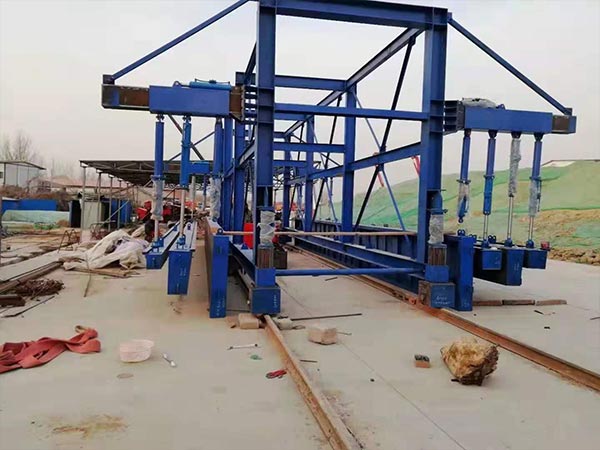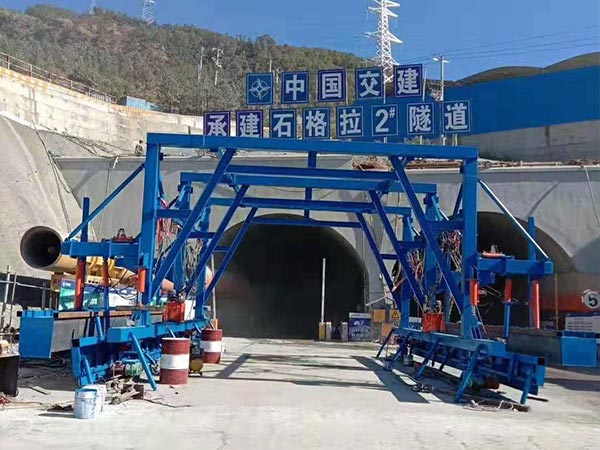In the current tunnel construction practice, considering the construction cost and construction speed, the selection sequence of the construction method is: full-section method→step method→circular excavation method with core soil method→intermediate wall method (CD method)→cross middle wall method ( CRD method)→Double-side pilot pit method; from the perspective of construction safety, the order of selection should be reversed. How to make the right choice should be comprehensively considered based on the actual situation, but it must meet the requirements of safety, speed, quality and environmental protection, so as to achieve the purpose of avoiding risks, accelerating progress and saving investment.
1. Full-face excavation method
The full-section excavation method is a construction method in which the lining is constructed by blasting and forming at one time according to the designed contour.
Applicable conditions:
(1) The surrounding rock of Grade I to IV, when used in Grade IV surrounding rock, the surrounding rock shall have the conditions to maintain its own stability during the period from full-face excavation to the initial support.
(2) There are drilling rigs or self-made work benches and high-efficiency loading and transporting machinery and equipment.
(3) The length of the tunnel or construction section should not be too short. According to experience, it should not be less than 1km. Otherwise, large-scale mechanized construction is adopted, which is less economical.
The tunnel mechanized construction has three main lines of operation:
Excavation line: drilling trolley, charging trolley, loader with dump truck (trackless transportation), slag loading machine with mining car and battery car or diesel locomotive (tracked transportation).
Anchor shotcrete operation line: concrete injection machine, concrete injection manipulator, anchor shot operation platform, feeding and transportation equipment and bolt grouting equipment.
Moulding and lining work line: concrete mixing equipment, concrete truck and pump, waterproof layer working platform, lining steel mould trolley.
Construction features of full-face method:
(1) Excavation section and work space are large and interference is small;
(2) Make full use of machinery and reduce manpower if possible;
(3) There are few procedures, which is convenient for construction organization and management, and improves working conditions;
(4) Excavation takes shape at one time, which has less disturbance to surrounding rock and is conducive to the stability of surrounding rock.

2. Step method construction
The step method is to excavate the upper half of the section first, and then excavate the lower half of the section at the same time after the excavation reaches a certain length, and the upper and lower half of the section go in parallel at the same time; according to the length of the steps, there are three types: long steps, short steps and ultra-short steps . In recent years, due to the design of large-section tunnels, there have been three-step temporary inversion methods and even multi-step methods.
As to which step method should be used in construction, it should be decided according to the following two conditions:
(1) The time required for the initial support to form a closed section. The worse the surrounding rock, the shorter the closing time.
(2) Requirements for the size of the construction site for the excavation, support, and ballasting of mechanical equipment used in the construction of the upper section.
In the weak surrounding rock, the former should be the main one, while the latter should be taken into consideration to ensure construction safety. When the surrounding rock conditions are better, the main consideration is how to better exert the mechanical efficiency and ensure the economic efficiency of construction, so only the latter condition should be considered.
Advantages and disadvantages of step excavation method:
The step excavation method can have enough working space and considerable construction speed. However, the upper and lower operations have interference; although the step excavation increases the number of disturbances to the surrounding rock, the step is conducive to the stability of the excavation surface. Especially after the upper part is excavated and supported, the lower part is safer, but attention should be paid to the influence of the lower part on the stability of the upper part.
Pay attention to the following points when excavating steps:
(1) Solve the problem of mutual interference between upper and lower half section operations. The micro steps are basically combined into one working face for simultaneous excavation; the long steps are basically opened, and the interference is small; while the short steps have greater interference, and attention should be paid to the work organization. For tunnels with a shorter length, the upper half of the section can be penetrated before the lower half of the section is constructed.
(2) When excavating the lower part, attention should be paid to the stability of the upper part. If the stability of the surrounding rock is good, the excavation can be carried out in stages; if the stability of the surrounding rock is poor, the lower excavation cycle footage should be shortened; if the stability is worse, it can be staggered to the left and right, or the middle trough can be pulled first before digging Side gang.
(3) After the excavation of the lower side wall, the concrete must be sprayed immediately, and the initial support must be made according to the regulations.
(4) The measurement work must be timely to observe the displacement value of the vault, the arch foot and the middle of the side wall. When the speed is found to increase, the invert arch should be closed immediately.

3. The core soil method for annular excavation
The following points should be paid attention to in the ring excavation method of retaining the core soil:
(1) The circular excavation footage should be 0.5-1.0m, and the core soil area should not be less than 50% of the entire section area.
(2) Spray anchor support and steel frame support shall be constructed in time after excavation. Adjacent steel frames must be connected by steel bars, and the angle lock anchor rod shall be designed and constructed according to the construction requirements.
(3) When the surrounding rock geological conditions are poor and the self-stabilization time is short, advance support should be carried out according to the design requirements before excavation.
(4) The excavation of the core soil and the lower steps should be completed and the shotcrete should reach 70% of the design strength.
4. Intermediate wall method (CD method)
The CD method is a construction method in which one side of the tunnel is first excavated in a large-span tunnel with weak surrounding rock, and the middle side wall is constructed, and then the other side is excavated. It is mainly used in double-track tunnels with deep buried hard rock in the fourth-level surrounding rock. Lots and old loess tunnels (class IV surrounding rock).
5. Cross-in-neighbor method (CRD method)
The method of intersecting walls is to excavate one or two parts of one side of the tunnel in a large-span tunnel with weak surrounding rock, apply the middle walls and diaphragms of the part, and then excavate one or two parts of the other side of the tunnel to complete Diaphragm construction; then excavate the last part of the first construction side, extend the middle wall, and finally excavate the remaining part. When the short-step method is difficult to ensure the stability of the face, the CRD method with a small section size should be used, which is more advantageous for controlling deformation.
The CD law is the abbreviation of “Center Diaphragm”, and the CRD law is the abbreviation of “Cross Diaphragm”. The two are both related and different. They are used in relatively weak stratum and large section tunnels. The former is a method of excavating by dividing the partition with steel support and shotcrete; the latter is a method of using the partition and invert to divide the section up and down, left and right for excavation, and the geological conditions require that the section is divided. The method adopted under timely closed conditions. Therefore, the only difference between the CRD method and the CD method is that each step of the construction process requires the use of temporary inverts to close the section.
In the CRD method or the CD method, a key issue is the removal of the middle wall. Generally speaking, the middle wall should be removed only after the full section is closed and the displacement of each section is fully stabilized.

6. Double side wall pilot pit method
The double-sided pilot pit method generally divides the section into four sections: the pilot pit on the left and right side walls, the upper core soil and the lower step. The principle is to use two intermediate walls to divide the entire large section of the tunnel into three small sections on the left, middle and right for construction. The hole is temporarily supported to form a full section. The pilot holes on both sides are in the shape of an inverted goose egg, which is conducive to controlling the sinking of the vault.
When the tunnel span is large, the surface subsidence requirements are strict, the surrounding rock conditions are particularly poor, and the single-side pilot method is difficult to control the surrounding rock deformation, the double-side pilot method may be used. Field measurements show that the surface subsidence caused by the double-side pilot pit method is only 1/2 of the short-step method.
Although the double-wall pilot tunnel method has many excavation sections and large disturbances, it takes a long time for the full section of the first support to be closed, but each section is closed immediately after excavation, so there is almost no deformation during construction. develop. The construction of the double-side pilot tunnel method is safe, but the speed is slower and the cost is higher. This method is mainly applicable to formations such as cohesive soil layer, sand layer and sand egg layer.
The construction sequence of the double-side pilot tunnel method is as follows:
(1) Excavate a pilot pit on one side and close it for the first time in time.
(2) Excavate the pilot pit on the other side after a proper distance, and construct the primary support.
(3) Excavate the upper core soil to construct the primary support of the arch, and the arch foot is supported on the primary support of the pilot pit on both sides.
(4) Excavate the lower steps and construct the first support at the bottom to close the full section of the first support.
(5) Remove the first support of the empty part of the pilot pit.
(6) Construct the inner lining.
Pay attention to the following points in the double-side pilot pit method:
(1) The next excavation can be carried out only after the sidewall pilot pit is excavated. When the geological conditions are poor, a temporary steel frame or a temporary invert should be installed at the bottom of each step according to the design requirements.
(2) When each part is excavated, the peripheral contour should be as smooth as possible.
(3) Excavation should be carried out on the other side after the strength of the shotcrete on the first excavation side reaches the design requirements.
(4) The longitudinal spacing of the excavation face of the pilot pits on the left and right sides should not be less than 15 meters.
(5) When the excavation forms a full section, the initial support closure of the full section shall be completed in time.
(6) The partition wall and temporary supports shall be removed section by section when the secondary lining is poured.

















